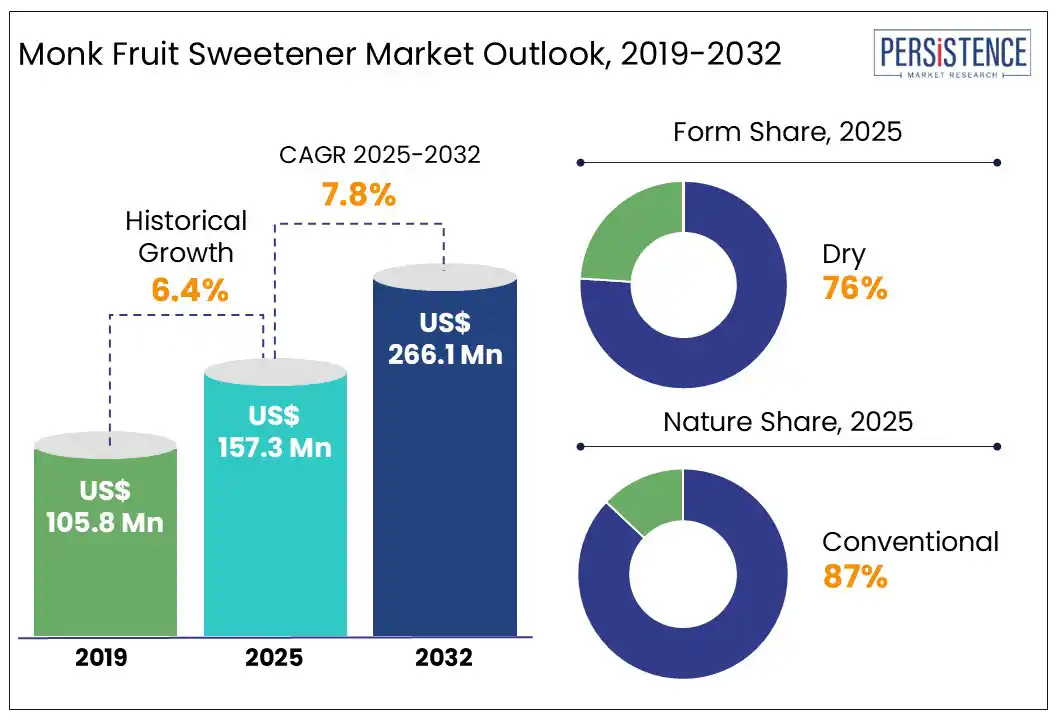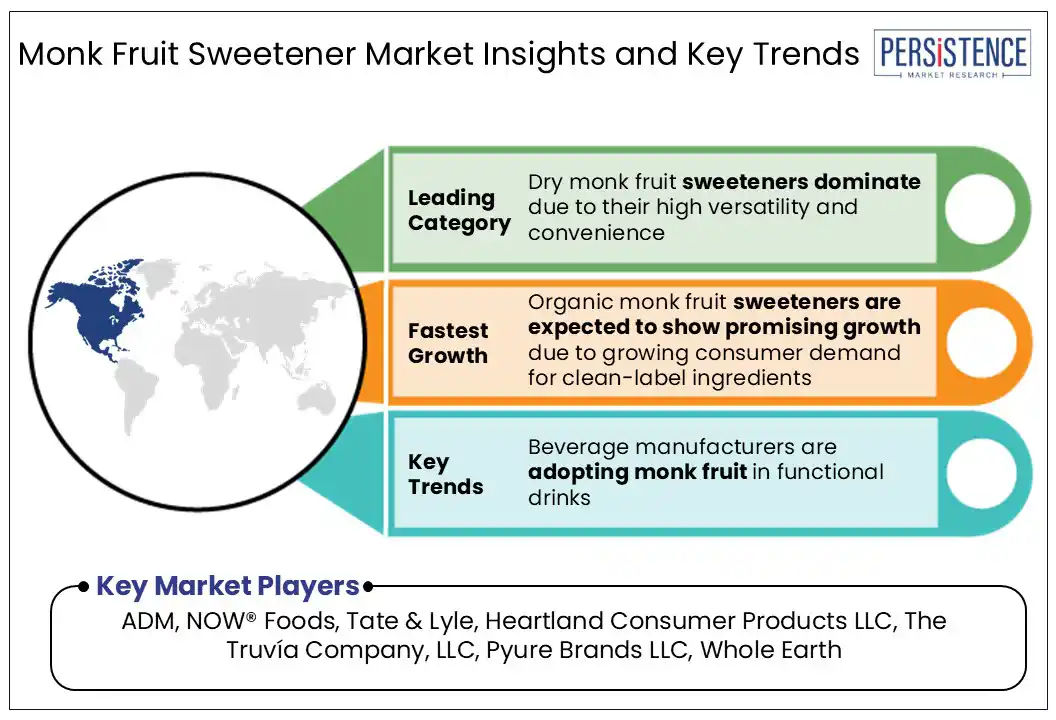ID: PMRREP34933| 192 Pages | 16 Jul 2025 | Format: PDF, Excel, PPT* | Food and Beverages

The global monk fruit sweetener market size is likely to be valued at US$ 157.3 million in 2025 and is expected to reach US$ 266.1 million by 2032, growing at a CAGR of 7.8% during the forecast period from 2025 to 2032.
Monk fruit sweetener, a natural, zero-calorie sugar alternative from the monk fruit, is gaining popularity among health-conscious consumers. Its intense sweetness and minimal impact on blood sugar make it ideal for those managing diabetes or seeking low-calorie options. It is derived from the monk fruit (Siraitia grosvenorii), this sweetener appeals to health-conscious consumers, particularly those managing diabetes or seeking low-calorie diets, due to its intense sweetness and lack of impact on blood sugar levels. The monk fruit sweetener market is gaining momentum as consumers prioritize clean-label, low-glycemic alternatives, organic formulations, and functional applications across global health-focused segments.

Key Industry Highlights:
|
Global Market Attribute |
Key Insights |
|
Global Monk Fruit Sweetener Market Size (2025E) |
US$ 157.3 Mn |
|
Market Value Forecast (2032F) |
US$ 266.1 Mn |
|
Projected Growth (CAGR 2025 to 2032) |
7.8% |
|
Historical Market Growth (CAGR 2019 to 2024) |
6.4% |
Increasing demand for natural sweeteners is a significant driver of market growth. It is mainly fueled by rising health consciousness and consumer preference for low-calorie, natural alternatives to sugar. As awareness about the adverse effects of excessive sugar consumption, such as obesity and diabetes, grows, consumers are actively seeking healthy options.
Monk fruit sugar substitutes, derived from natural sources and free from artificial additives, have gained popularity for their zero-calorie and low glycemic index benefits. Additionally, the shift toward clean-label and organic food products supports demand for natural sweeteners. This trend is amplified by regulatory support and growing adoption of plant-based ingredients in the food and beverage industry.
Regulatory challenges and approval processes pose significant barriers to the growth of the monk fruit sweetener market. Varying food safety standards and labeling requirements across several regions create complexities for manufacturers, delaying product launches and market entry. In some countries, these sweeteners face stringent approval processes, requiring extensive testing and documentation to meet compliance standards. Similar regulations increase costs and time to market, discouraging small-scale players from entering the industry. Inconsistent categorization of monk fruit extracts, such as natural sweeteners or food additives, lead to regulatory ambiguities. Addressing these challenges requires harmonized global standards and transparent processes to support industry growth and ensure consumer trust in product safety.
Integration of organic monk fruit sweeteners into sports and nutrition supplements offers promising growth opportunities. With a rising focus on health and fitness, consumers are increasingly seeking low-calorie, natural ingredients in protein powders, energy drinks, and meal replacements. Monk fruit sweeteners, being calorie-free and offering a clean-label alternative to artificial sweeteners, align well with these preferences. Their natural origin and low glycemic index make them ideal for athletes and health-conscious individuals. A strong example of this trend is MuscleBlaze Biozyme Gold 100% Whey Protein, which is sweetened with monk fruit to deliver both functional performance and clean nutrition. Their ability to blend seamlessly without altering the flavor profile enhances their appeal in supplement formulations. Rising applications in this sector are set to drive demand, fostering growth and creating a niche for these sweeteners in the health and wellness market.
Dry monk fruit sweeteners are likely to account for a substantial share of 76% as of 2025 owing to their high versatility and convenience in several culinary applications. It makes them highly favored by both consumers and manufacturers. Dry monk fruit sweeteners are easy to incorporate into a wide range of food products, from baked goods like cakes and cookies to beverages, serving as an ideal sugar substitute. Their ability to mimic sugar's texture and sweetness, as seen in products like Lakanto's granulated sweeteners, contributes to their popularity.
The dry format also offers greater shelf stability and ease of storage, which further enhances its appeal in both household and industrial use. As health-conscious consumers increasingly seek natural, low-calorie alternatives, the demand for dry monk fruit sweeteners continues to rise.
Organic monk fruit sweeteners are expected to grow at a positive CAGR during the forecast period from 2025 to 2032 as consumers increasingly demand clean-label ingredients that align with natural and transparent product sourcing. With the rising concerns over synthetic additives and artificial sweeteners, organic certifications offer reassurance of purity, sustainability, and minimal chemical processing. This is especially relevant in health-focused categories such as sports nutrition, functional beverages, and plant-based supplements, where formulation transparency influences purchasing decisions. Organic monk fruit’s appeal lies in its zero-calorie profile, low glycemic impact, and plant-based origin, making it suitable for diabetics, fitness enthusiasts, and clean-eating consumers. While conventional monk fruit sweeteners continue to hold a large share of the market due to affordability and widespread availability, the organic segment is gaining momentum in premium product lines and export-oriented markets.

North America monk fruit sweetener market is projected to witness a CAGR of 6.9% through 2032, driven by rising health consciousness and regulatory support. In the U.S., the FDA has classified monk fruit sweeteners as Generally Recognized as Safe (GRAS), affirming their safety for all population groups, including children, pregnant women, and individuals with diabetes. Consumers across the U.S. are increasingly choosing monk fruit as a zero-calorie, natural alternative to sugar, spurred by growing awareness of the health risks associated with added sugars. The sweetener’s low glycemic index and clean-label appeal are gaining favor in ketogenic, diabetic-friendly, and paleo diets. Canada has also acknowledged monk fruit as safe, further expanding its use in clean-label food and beverage innovation. Strategic partnerships between ingredient producers and food manufacturers are accelerating mainstream adoption, positioning monk fruit as a key component of North America's evolving natural sweetener landscape.
Europe is expected to gain a CAGR of 7.4% during the forecast period. Dietary recommendations and public health efforts, such as the EU's ‘Farm to Fork’ plan, are encouraging reduced sugar intake and the pursuit of healthier, more sustainable diets. This trend has led individuals and businesses to seek natural, sugar-free alternatives. As a result, monk fruit is becoming the ideal choice for sweetening foods without adding extra calories or artificial ingredients.
European consumers are highly concerned about the sustainability and transparency of food production. Consumers’ demand for clean-label products that are minimally processed and free of artificial ingredients is fulfilled by liquid monk fruit sweeteners. Brands like Pure Via and Whole Earth have launched monk fruit-based items tailored to local preferences, including low-calorie jams, syrups, and tabletop sweeteners.
The monk fruit sweetener market is highly competitive due to rising global demand for clean-label, low-glycemic sugar alternatives. Leading firms are diversifying their product offerings, including monk fruit formulations without erythritol, to cater to clean-label and additive-free preferences. Strategic initiatives such as mergers, global partnerships, and collaborations with major food and beverage manufacturers are central to expanding market presence. Companies are investing in sustainability, ethical sourcing, and industry certifications to align with evolving regulatory and consumer standards. Improving taste and functionality remains a priority, with R&D teams refining flavor profiles and solubility for broader application in beverages, baked goods, and supplements. By combining innovation with tailored marketing strategies, players are positioning monk fruit as a mainstream solution in the health-conscious sweetener segment.
The global Monk Fruit Sweetener market is projected to be valued at US$157.3 Mn in 2025.
Rising concerns of obesity and diabetes are driving interest in Monk Fruit Sweetener.
The Monk Fruit Sweetener market is poised to witness a CAGR of 7.8% between 2025 and 2032.
Companies can use monk fruit blends in sports supplements as the key market opportunity.
Major players in the Monk Fruit Sweetener market include ADM, NOW® Foods, Tate & Lyle, Heartland Consumer Products LLC, The Truvía Company, LLC, Pyure Brands LLC, Whole Earth, and others.
|
Report Attribute |
Details |
|
Historical Data/Actuals |
2019 - 2024 |
|
Forecast Period |
2025 - 2032 |
|
Market Analysis |
Value: US$ Mn |
|
Geographical Coverage |
|
|
Segmental Coverage |
|
|
Competitive Analysis |
|
|
Report Highlights |
|
|
Customization and Pricing |
Available upon request |
By Form
By Nature
By End-use
By Distribution Channel
By Region
Delivery Timelines
For more information on this report and its delivery timelines please get in touch with our sales team.
About Author